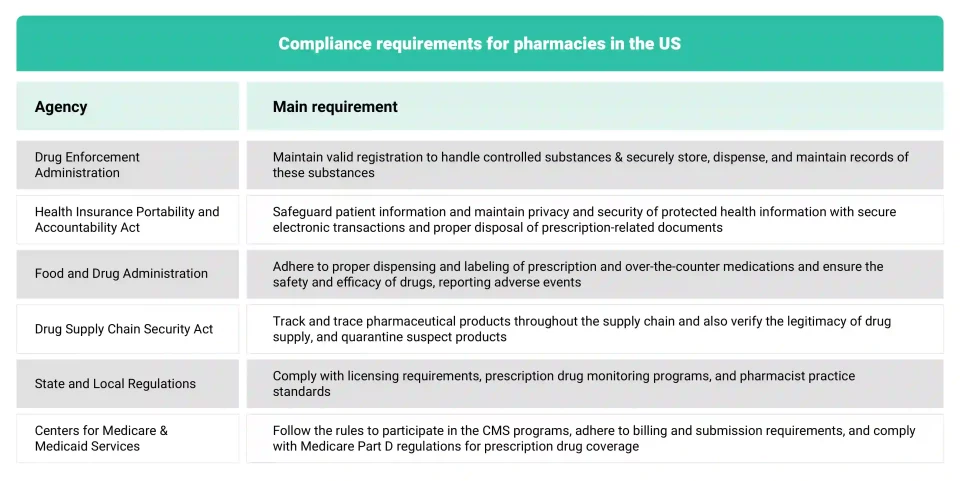INTRODUCTION
Control drug stock with pharmacy inventory management software
The US healthcare system is continually adapting to new technologies, fresh implementation statutes, and regulatory reforms. The role of the pharmacy and the pharmacist is also undergoing a sea change.
The pharmacist is a highly qualified medical professional who spends an inordinate amount of time in:
- Dispensing medication (counting pills, verifying dosage)
- Reviewing prescriptions (checking for adverse reactions and side effects)
- Counseling patients (studying medication history for duplication)
- Collaborating with providers (optimizing medication regime)
- Monitoring polypharmacy (multiple drug consumption by aged patients)
- Providing over-the-counter recommendations (guidance on usage)
- Point-of-care testing services
This blog is aimed at educating pharmacists on the benefits of healthcare asset inventory management in pharmacy to relieve them of some of the burden of work that may be a less critical aspect of their profession.
Pharmacists have to contend with administrative chores, upskilling to use new technologies, operational tasks, and financial responsibilities, not to mention keeping pace with government mandates.
The latter is the most challenging, with pharmacies found guilty of non-implementation or inadequate compliance. This is despite the availability of technology solutions, data-driven strategies to streamline workflows, and healthcare software development services that offer interoperable solutions.
For instance, do you know that even after a decade after the Drug Supply Chain Security Act (DSCSA), pharmacies have not updated their systems to ensure compliance? The deadline on November 27 is already here, and not enough has been done to protect patients from harmful drugs.
More on this later in the blog; first, let us get on with the virtues of pharmacy inventory management software.
DEFINITION
What is pharmacy inventory management software?
Pharmacy inventory management refers to the systematic oversight and control of pharmaceutical stock within a pharmacy or healthcare setting. Software that enables this aims to ensure efficient supply chain operations, minimize waste, and maintain optimal levels of medications and healthcare products.
Automating the process where possible helps to streamline tasks like ordering, receiving, storing, and dispensing medications, in addition to monitoring expiration dates, managing product recalls, and complying with FDA directives.
If pharmacy inventory management software is customized to meet all the needs, pharmacies will succeed in striking the right balance between meeting patient’s needs and avoiding excess inventory to prevent financial inefficiencies.
No matter what the specific needs of the pharmacy may be, the software can be tailored to minimize errors, reduce manual labor, and optimize stock levels based on demand patterns.
Unless pharmacies adopt pharmacy inventory management best practices like building a custom pharmacy software, it will become increasingly challenging to offer patients and providers an efficient and easy way to search for and purchase the drugs they need. So, the first step is to understand the features of a pharmacy inventory management solution.
Unlock the potential of efficient pharmacy operations with our cutting-edge inventory management software solutions.
FEATURES
Top five features of pharmacy inventory management software
A robust pharmacy inventory management software solution is always designed to be flexible, scalable, interoperable, and adaptable to the evolving needs of a pharmacy while ensuring compliance with industry regulations. The most important features include:
Order management: Automating the order process based on demand forecasts and inventory levels. The software can be designed to generate orders when stocks fall below a specified threshold.
Stock tracking: Monitoring the inventory in real-time. Pharmacy inventory management software updates the stock movement both when medicines are dispensed and when a fresh supply is received.
Expiration alerts: Notifying staff about medications that are nearing expiration date. This prevents dispensing out-of-date products and can be used to identify drugs that have a shelf-life of 90 days.
Reporting and analytics: Tracking metrics on the performance of drugs. Generates reports on stock levels, turnover rates, sales, and re-order points of a drug or a category of drugs. Helps to develop clinical advanced insights.
Permissions and security: Implementing role-based access control. Core functions like dispensing and non-core administrative tasks can be demarcated. Used to log modifications to inventory with user, date, and time stamps.
In addition, some pharmacy chains include multi-location support with centralized control, and some others allow users to access the system from mobile devices to help staff place orders through a mobile app.
INTEGRATIONS
Integration of customized modules for holistic pharmacy management
To capitalize on the benefits of inventory management in pharmacy, integration of individual modules is recommended. These modules may pertain to:
- E-prescription
- Regulatory compliance
- Supply chain mobile apps
- Purchase orders management
- Billing and reimbursements
Let us take a closer look at a couple of these integrations.
E-prescription
The integration of an e-prescription module aligns with the larger goal of digitization of healthcare processes. It improves accuracy, efficiency, and patient safety in medication management. It links the prescriber, patient, and pharmacist and automates the entire process. Here is how it would work:
The e-prescription is sent out by the doctor through an electronic health record (EHR) system. It is received by the pharmacy -complete with patient information, name of medication, and dosage. The pharmacy inventory management software dispenses the medication and updates the inventory level while the pharmacist may counsel the patient on adherence. Just as an interoperable EHR is at work at the prescriber's end, an interoperable regulatory compliance solution will help the pharmacist play by the book.
You can read about a real-world e-prescription solution custom-developed by Asahi Technologies with a module for consultation, compliance, and an interactive portal included.
Regulatory compliance
The integration of a compliance module into pharmacy inventory management software reduces the heavy regulatory burden on pharmacies. Take the DSCSA compliance mentioned earlier in this blog, for example. Pharmacies have to enable the tracking and tracing of all drugs with solutions that are fully interoperable to enable timely, secure, and accurate electronic data exchange. The mandate for pharmacies includes prevention, detection, and response, as they are seen as the last line of defense against spurious drugs. This means:
- Check and engage only with licensed or registered trading partners.
- Enable tracking and tracing of all drugs with solutions that are fully interoperable with all stakeholders.
- Set up a process to verify the authenticity of the drug, validate it, or report if counterfeit, quarantining suspect medications.
Fortunately, the FDA has announced a stabilization period of one year, and pharmacies have another year to implement or fine-tune the on-premises verification processes before enforcement begins in November 2024.
As dispensers, pharmacies should follow pharmacy inventory management best practices to harness technologies such as electronic data exchange, shared record database, blockchain, and barcode scanning for traceability. Here is how it would work:
When fulfilling an e-prescription, the barcode of a medication package is scanned, and the compliance software traces unique product identifiers (serial and lot numbers, expiration dates. The data is then acted upon, stored, and retrieved when needed to ensure the safety and integrity of the pharmaceutical supply chain.
We incorporate multiple useful features in our products to optimize your workflows and operations.
 Compliance software can be integrated into pharmacy inventory management
Compliance software can be integrated into pharmacy inventory management
BENEFITS
Serve patients better with pharmacy inventory management software
There are many benefits that accrue with the use of software for pharmacy inventory management. Here are a few:
- The use of pharmacy inventory management software augments operational effectiveness and boosts efficiency due to smooth workflows, streamlined processes, and real-time updates.
- Optimized inventory levels prevent overstocking and stockouts, reduce waste, and ensure the availability of medications.
- Minimizing excess stocks reduces carrying costs, helps to make informed purchasing decisions and leads to financial savings.
- Automation of routine tasks saves time and reduces manual work and errors.
- Elimination of errors in dispensing medications means there are no adverse events and patients are safe.
- Flawless inventory tracking prevents the dispensing of expired and recalled medications, promoting patient care.
- Faster prescription processing, better decision-making, increased accountability, and improved stakeholder relationships help to build a patient-centered pharmacy experience.
CONCLUSION
Custom-design interoperable pharmacy inventory management software
The use of pharmacy inventory management software and its integration with interoperable solutions helps to modernize pharmacies, and catapults pharmacists into a more active role in patient care. Custom-designed with the objective of streamlining operations, enhancing patient safety, and ensuring regulatory compliance, pharmacy inventory management software can be an effective tool in the digital transformation of contemporary healthcare.
Explore pharmacy management software solutions with us to improve medication safety.






